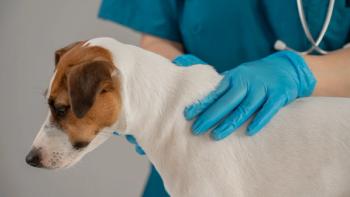
The itchy cat? (Proceedings)
The first step in approaching the case of the "alopecic" cat is demystifying and differentiating the true motivation behind the activities of the over grooming cat from the truly intensely pruritic cat, which then drives the diagnostic tests for differentiating medical versus behavioral problems in the feline.
The first step in approaching the case of the "alopecic" cat is demystifying and differentiating the true motivation behind the activities of the over grooming cat from the truly intensely pruritic cat, which then drives the diagnostic tests for differentiating medical versus behavioral problems in the feline.
Pruritic cats do not look like pruritic dogs...
Dogs frequently have complicated dermatologic disorders and present with a myriad of secondary infections that include pyoderma, yeast dermatitis, yeast and/or bacterial pododermatitis, otitis, demodicosis, and dermatophytosis. Of these infectious dermatologic disorders, the only one commonly diagnosed in the cat is dermatophytosis. However, if caused by Microsporum canis, this condition is expected to be non-pruritic in the cat.
Pruritic cats tend to present with lesions that may or may not initially appear to be inflammatory in nature at all. The cat that is licking, scratching, biting may only present with multifocal areas of alopecia, miliary dermatitis, or one of the 3 lesions that comprise the eosinophilic granuloma complex (eosinophilic plaque, indolent ulcer and/or the linear granuloma).
Alopecia = "the bald belly syndrome"
Frequently there are no obvious skin lesions present and the owner may not witness the cat grooming the affected areas. However, even if the cat is not a "private" groomer, the disorder may still be labeled as behavioral in nature and pruritus as a contributing factor may in fact be overlooked. Often the alopecia is even in distribution, owing to the feline tendency to groom symmetrically, and it can be focused on the trunk, similar to the endocrine alopecia pattern seen in dogs. Because alopecia is not typically associated with common endocrinopathies in the cat, such as diabetes mellitus and hyperthyroidism, this category of disease does not normally appear on the differential diagnosis list of the clinician when presented with a cat with this striking pattern of alopecia. The majority of cats that present with this syndrome have a medical and pruritic reason for their alopecia. The top differential diagnosis for a more mildly affected patient is the contagious form of demodicosis caused by the mite Demodex gatoi, followed by atopic dermatitis, cutaneous adverse reaction to food, and flea allergic dermatitis.
Miliary dermatitis = pruritic or non-pruritic?
This lesion in the cat may be pruritic OR non-pruritic. If the patient presented has a history of pruritus in association with these lesions, the top differential diagnosis on the list at this point in time is flea allergic dermatitis. If the patient is reported as being non-pruritic, the top differential diagnosis is dermatophytosis caused by Microsporum canis. The cat serves as the natural host for M. canis, therefore a varied inflammatory response occurs and it the patient is very rarely pruritic. Despite the presence or absence of erythema, seborrhea and / or alopecia present, the most important historical clue is the presence or absence of pruritus.
Eosinophilic granuloma complex = a reaction pattern, not a diagnosis
The three lesions that comprise this reaction patterns include the eosinophilic plaque, indoldent or "rodent" ulcer, and the linear granuloma. Regardless of which lesion is present, the differential diagnosis list remains essentially the same: Flea allergic dermatitis, cutaneous adverse reaction to food, or atopic dermatitis (environmental allergic disease). Surface cytology of one of these lesions should reveal the presence of many eosinophils; occasionally neutrophils and / or surface bacteria may also be noted, especially if the cat is licking the lesion. Neoplasia is a differential diagnosis for some of the more severe lesions and can be ruled out with biopsy for histopathology, however most of the common cutaneous neoplasms are not eosinophilic in nature and a simple surface cytology of the lesion should help the clinician further clarify the primary type of lesion present.
Treatment options for cats
1. Repositol steroid injections = ideally no more than every 3 months
2. Lime sulfur dip trial
3. Stringent flea control program
4. Allergy testing
a. Serum testing
b. Intradermal allergy testing
5. Elimination diet trial
6. Cyclosporine treatment trial
Newsletter
From exam room tips to practice management insights, get trusted veterinary news delivered straight to your inbox—subscribe to dvm360.






